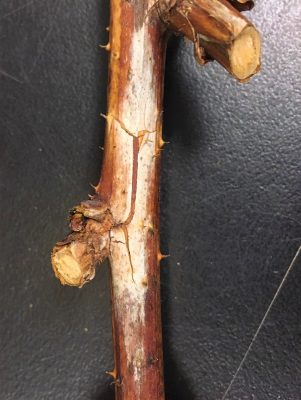
It is a familiar trope to many of us who buy raspberries in the grocery store. They look fine when you take them off the shelf, give them a rinse at home, and put them in the refrigerator for safe storage. You are excited to put them on your oatmeal, or blend them up in a smoothie. When morning comes, you open the plastic clamshell only to find the berries covered in a gray fuzzy mold. What gives? How did it happen so quickly?
The fuzz you are seeing is Botrytis cinerea, a common fungus that can infect hundreds of species of plants, and raspberries are a particularly preferable host. Botrytis thrives in humid conditions, and can spread extremely quickly. Over 60,000 Botrytis spores can be produced on a single raspberry, and it only takes one spore to cause a new infection. So while you may have rinsed the berries to ensure they were clean and ready to snack on right out of the fridge, those moist conditions were the perfect environment for Botrytis to take hold inside your clamshell.
If you grow raspberries in your own garden, you have more than likely seen Botrytis in your berry patches too. The fungus overwinters as sclerotia, which are black blister-like structures that often protrude from white lesions on canes. During periods of wet weather, spores are produced and disbursed from plant to plant by wind and rain splash. You may see the gray mold colonizing your berries just after the first fruit has ripened. Though, the more overripe the fruit becomes, the more likely the berries will rot and become colonized by Botrytis. If the infection is not managed, serious damage and yield losses can occur on your berry patches. In fact, Botrytis fruit rot is the most common and important disease on raspberries worldwide.
To control the spread of Botrytis in your raspberry (and blackberry) plantings at home, prioritize cultural practices that limit humidity. Ensure your site has good airflow by pruning canes, thinning rows, and controlling weeds. A trellising system can also help train canes upwards, preventing them from falling onto one another. Avoiding excessive nitrogen fertilizer application can help prevent plants from putting out more foliage than necessary.


Good sanitation is also key. Remove overripe fruit, spent flowers, any plant material that appears gray or fuzzy, or canes that have large lesions or black blisters on them. Do not compost infected plant parts, as home compost systems are not able to reach adequate temperatures to kill the fungus. Planting with resistant cultivars, or at the very least, not highly susceptible cultivars, can also help provide some protection.
There are some fungicide applications that can be used for Botrytis, but they will not be effective if the above cultural and sanitation recommendations are not taken. Check with UConn’s Home & Garden Education Center (http://ladybug.uconn.edu) or Plant Diagnostic Laboratory (http://plant.lab.uconn.edu) for more recommendations.
If you still want to buy and eat raspberries from the store, not all hope is lost. You can try one of two options. The first is to buy frozen raspberries, and only take them out of the freezer in a quantity you know you’ll consume in that sitting. Frozen raspberries are great in smoothies and can replace the need for ice. The other option is to take the berries home and store them in the refrigerator with a dry paper towel to help wick away moisture. Then, you can give the fresh berries a rinse just before you’d like to enjoy them. While raspberries may feel like a bit of work to be able to eat them, they sure are tasty!